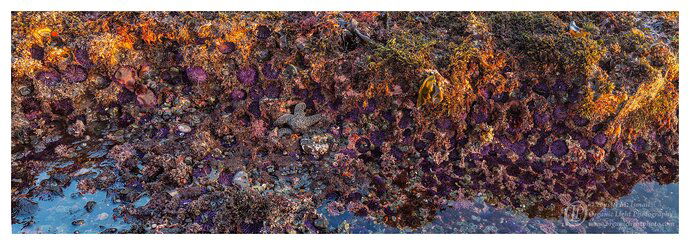On my second day at the Fitzgerald Marine Reserve, I was wandering for most of the afternoon as I was looking for a portion of the exposed sea floor that contained EVERYTHING. I wanted to show the amazing diversity of organisms that inhabited this small stretch of coast. I was also fortunate to have found such a spot at a time when there was some gorgeous light filtered naturally by the heavy mist in the air, giving the light that golden glow typical in the last hour of the day.
In this small 25-foot stretch of the coastal sea floor, if you look carefully you will find, an Ochre Star, Derby Hat (a red kind of moss), Purple Urchins, Turban Snails, Giant Green Anenomes and Sunburst Anenomes (all closed, unfortunately), Rough and Volcano Limpets, Spindled Rockweed, Devil Weed, Sea Cabbage, Wakame, Sea Lettuce, Encrusting Coralline, Tidepool Coralline, and Red Comb Weed…Phew.
I am posting this bigger than usual so that you can zoom in and really look at all the detail.
Specific Feedback Requested
Two things.
One, are the colors too saturated? I already backed off the saturation, but I don’t want to lose that aspect of the scene, but I want it to be realistic.
Two, Is it too much? Is there just too much stuff for a viewer to absorb in a single photo?
Technical Details
Nikon D850, Nikon 50mm f/1.8 MF lens at f16, 1/2 sec, ISO 100, six vertical frames stitched together in PS CS6, RAW processed in LR Classic.
